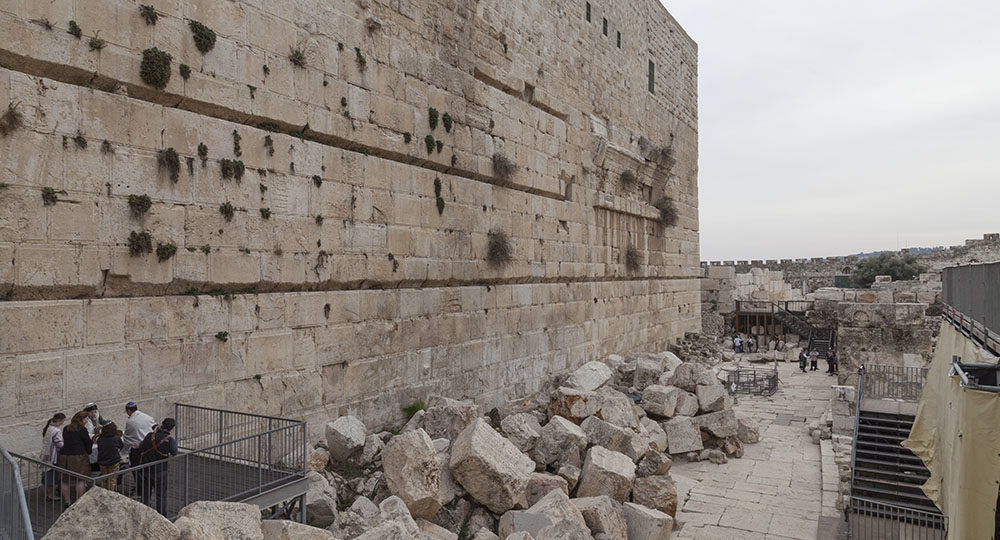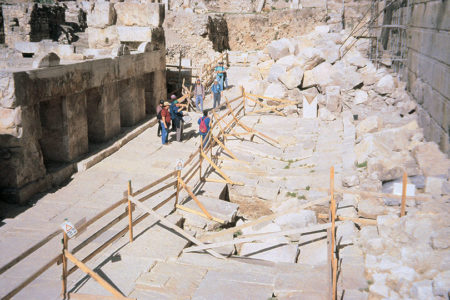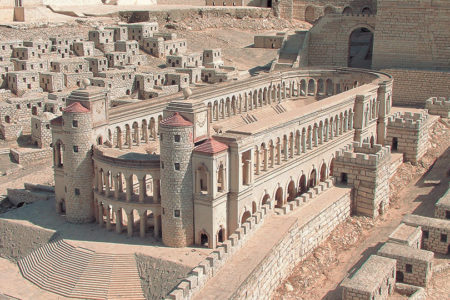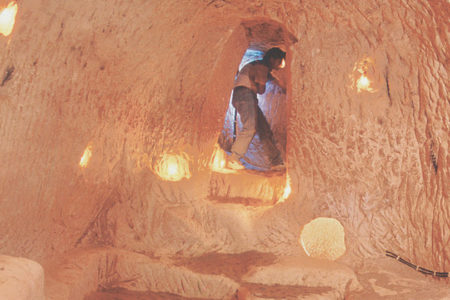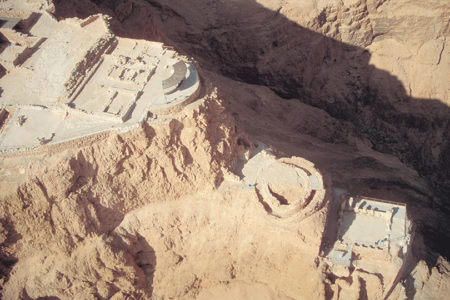Jerusalem, Oh Jerusalem
For more than a century the Jewish people had suffered the humiliation of subjugation to Rome. Entering Jerusalem in 63 B.C., the triumphant Roman general, Pompey, had even dared to enter the holy Temple, initiating a period of Temple defilement that intensified the Jewish nation’s loss of independence. Nevertheless, as long as the Temple stood and a Jewish king (Agrippa) ruled, future independence remained a hope.
Therefore, as the century drew to a close, rising Messianic expectation combined with Jewish nationalistic aspiration and conflicting political ambition. From Rome’s perspective, Judaism was an insufferable autonomy, tolerated only to keep Jewish nationalism in check. However, once religious ideals ignited such nationalism, Rome was sure to intervene.
In A.D. 44, King Agrippa’s death placed the whole country under direct Roman rule, removing the illusion of Jewish independence. Mounting Roman oppression, the siding of Roman authorities with the non-Jews in the land, and repeated violations of the Temple’s sanctity created an atmosphere for revolt. In April of A.D. 66, when the Roman governor confiscated seventeen talents from the Temple treasury, Jewish nationalists rebelled. They seized the Temple, stopped the daily sacrifices in tribute to the Roman emperor, and captured the stronghold of Masada.
The Revolt
The Great War, or First Jewish Revolt, was unique in the region’s history because the Jews were the only people in the ancient Near East to launch such a large-scale revolution against the Roman Empire. Unique also is the fact that no other ancient conflict has been preserved in such complete detail by an eyewitness. This historian and eyewitness was the first-century Jewish man Yosef ben Mattityahu, better known as Flavius Josephus. Josephus was a former Pharisee and commander of Jewish nationalist forces in the Galilee. Roman historian Dio Cassius provided another important account. His was based on official military records.
In response to the Jewish insurrection, staged primarily in Jerusalem, Rome’s leading commander, Vespasian, was dispatched to quell the uprising with about fifty thousand soldiers. Vespasian’s attack began in northern Israel, which, unlike Jerusalem, offered little resistance. For example, the Jewish families at the Galilean fortress of Jotapata, defended by Josephus’s forces, committed suicide rather than surrender; and Josephus turned to the Roman side.
An exception was the city of Gamla in the Golan Heights, which attempted to prevent the Roman advance toward Jerusalem in the fall of A.D. 67. However, the Romans decimated the city, slaughtering four thousand Jews. Rather than allow their families to fall to Roman savagery, about five thousand Jewish people took their own lives, plunging off nearby cliffs to their deaths. This heroic stand later earned the site the title “The Masada of the North.”
The Siege
By the summer of A.D. 70, Vespasian’s Tenth Legion had made its way to Jerusalem and placed the city under siege. Because of the influx of refugees from other Jewish cities destroyed by the Romans, in addition to Judeans fleeing the legions, the city’s population had at least tripled. Jerusalem’s reputation as both impregnable and large (it was one of the largest cities of the ancient world) made it a significant challenge to the already wearied Roman soldiers. However, because it was the center of political and spiritual authority and the center of the Jewish revolt, Jerusalem also was destined to become the foremost example of Roman punishment.
At the time of the Roman siege, two of the most militant Jewish nationalist factions, the Zealots and the Sicarii, had gained control of the Temple Mount with the aid of Idumean mercenaries (descendants of the Edomites). The Idumeans had ruthlessly killed the more moderate Sadducaic and Pharisaic elements in charge. The militants’ aim from the beginning was to crush the Roman occupation of Israel and drive the Romans from the land. Now that the war had come to the holy city, they were determined to prevail or perish.
To assure that the city’s Jewish population would not flee but fight to the death, the Zealots destroyed the food storehouses while proclaiming the divine inviolability of Jerusalem. Since the only way out of the city was in a coffin, a leader of the Pharisaic sect, Rabbi Yochanan ben Zakkai, escaped by hiding in one and surrendering to Vespasian.
Upon being delivered to the general, he addressed him as emperor and said God would allow only a great ruler to capture His city. According to tradition, a messenger from Rome arrived at that moment, telling Vespasian the emperor had died and that Vespasian had been crowned his successor.
Impressed by the rabbi’s prophecy, the new emperor permitted the rabbi to safeguard the Torah scroll and its sages in the city of Yavneh. Thus, although the Temple was destroyed, the Torah was not; and though Jerusalem was spoiled, Judaism was spared.
The Final Assault
Vespasian returned to Rome to assume his duties as emperor, giving his son Titus, in command of the Tenth Legion, the charge of completing Jerusalem’s submission. Despite the famine inside the city, the Jewish people celebrated a final Passover with their Temple and prepared for the Roman attack.
It came days later with a catapult barrage that continued for two months until the Romans finally breached the walls. Proceeding house by house, the Romans set fire to the city, slaughtering every Jew in their wake. One archaeological testimony to the fierceness of the fighting is the “Burnt House” within the present Jewish Quarter. Here you can see the debris of one of the houses destroyed by the Romans in A.D. 70, with the remains of a woman holding a spear, lying on the doorstep where she was killed.
Though weakened by hunger, the Jewish defenders repelled the Roman assault from the Temple Mount for three weeks. Then, on the ninth of the Jewish month of Av (August), the Romans reached the second-Temple compound. This was, providentially, the same day the first Temple was destroyed by the Babylonians 656 years earlier.
Dio Cassius described the final opposition of the Jewish people nestled around the sacred precinct:
The populace was stationed below in the court and the elders on the steps and the priests in the Sanctuary itself. And though they were but a handful fighting against a far superior force, they were not conquered until part of the Temple was set on fire. Then they met their death willingly, some throwing themselves on the swords of the Romans, some slaying one another, others taking their own lives and still others leaping into the flames. And it seemed to everybody and especially to them that so far from being destruction, it was victory and salvation and happiness to them that they perished along with the Temple.
The Romans next plundered the Temple, removing every item of value. Later these Temple treasures were displayed in Rome during a victory procession, carried by thousands of Jewish slaves. The image of this event remains to this day in the Roman Forum, etched in one of the reliefs on the monument known as the Arch of Titus’ Triumph.
Once the Temple was ignited, the Romans chopped down the trees in the area to form a huge bonfire around the structure. The moisture in the Temple’s limestone blocks expanded and blew the stones apart, collapsing the holy structure in a single day.
The
Question? ‘Why?’
Josephus noted that the Temple was demolished contrary to the specific orders of Titus, who wished to preserve it. Indeed, Roman policy was to control a conquered people’s temples, then grant a resumption of its services as an act of clemency for proper submission. Some scholars believe the Roman soldiers, half-crazed because of the duration of Jewish resistance and the desire to plunder the Temple’s wealth, deliberately set it ablaze.
Some Jewish sources claim the fire started accidentally when a soldier’s torch caught the curtains of the sanctuary. However, when my classmates at Hebrew University in Jerusalem argued these options, they found no theory satisfactory. Turning to our Orthodox Jewish professor, Isaiah Gafni, we asked what he thought. With a pause and then a smile, he said, “Maybe Jesus was right!” Whether this answer was a rabbinic debate tactic or an unconscious flash of inspiration, it effectively ended any further questions.
The rabbis declared that the reason for the Temple’s destruction was sinatchinam, “senseless hatred” among Jews. According to this idea, the fierce rivalry between the Jewish sects erupted in a type of civil war, dividing the Jewish people, angering God, and exposing the nation to both divine judgment and Roman onslaught.
Yet, if Professor Gafni’s supposition is considered, Jesus stated the principal cause of Jerusalem’s destruction:
For the days shall come upon thee, that thine enemies shall cast a trench about thee, and compass thee round, and keep thee in on every side, And shall lay thee even with the ground, and thy children within thee; and they shall not leave in thee one stone upon another; because thou knewest not the time of thy visitation (Lk. 19:43–44; cf. Mt. 23:37–38; Acts 3:13–15).
The national rejection of Jesus as the promised Jewish Messiah served, along with many other internal factors, as the climactic act that brought divine judgment. Although this judgment ended the institution of the Temple and forced a reformulation of Judaism, it did not end the Jewish people or the unconditional, covenantal promises of national restoration and future blessing through Messiah. Jesus had included this hope even in His prophetic pronouncement against Jerusalem and the Temple in Matthew 23:38–39: “Behold, your house is left unto you desolate. For I say unto you, Ye shall not see me henceforth, till ye shall say, Blessed is he that cometh in the name of the Lord.”
The apostle Paul, basing his teaching on the prophecies of Isaiah, taught that this day of Jewish national repentance will one day arrive with the return of Jesus to Jerusalem: “And so all Israel shall be saved; as it is written, There shall come out of Zion the Deliverer, and shall turn away ungodliness from Jacob; For this is my covenant unto them, when I shall take away their sins” (Rom. 11:26–27).
The call for this repentance toward Jesus as Messiah came from many pious Jews before the Temple’s destruction and continues even today. The apostle Peter, who issued this call in second Temple times, reminds us that the hope of Israel’s restoration rests on her repentance:
Repent, therefore, and be converted [return], that your sins may be blotted out, when the times of refreshing shall come from the presence of the Lord; And he shall send Jesus Christ [Messiah], who before was preached unto you, Whom the heaven must receive until the times of restitution of all things (Acts 3:19–21).
When any Jewish person, and ultimately the Jewish nation, answers this call, the disaster of the Great War will be turned to the deliverance of the Great Redemption.
